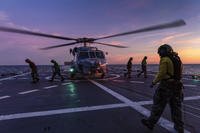The first of four Air Force KC-46A baseline test aircraft will complete major assembly later this month before taking off on its first scheduled test-flight later this summer, Air Force and Boeing officials said.
Although only a developmental flight of a test aircraft, the upcoming flight marks a significant milestone in a long Air Force effort to build a new aerial tanker for its fleet.
The upcoming test flight of the 767 2C developmental aircraft, called a provision freighter, will begin an extensive testing, evaluation and certification process in the Air Force’s multi-year effort to replace its aging KC-135 and KC-10 tanker fleets, Maj. Gen. John Thompson, Program Executive Officer for Tankers, told Military.com in an interview.
“The first aircraft will go directly into the flight test program where it will start working on FAA certification test points – proving that the aircraft can fly at the altitudes it is committed to flying at, proving that it can take off and land at the distances it has committed to, and ensuring that it can go from one altitude to another altitude,” Thompson said.
The Air Force’s multi-year tanker procurement program is one of the service’s top two priorities. The average KC-135 is about 50 years old and the average KC-10 tanker is roughly 29 years old, Thompson said.
The 165-foot KC-46A is being built with Pratt and Whitney engines and the ability to transport up to 212,000 pounds of fuel and 65,000 pounds of cargo. The aircraft will bring an improved ability to conduct aerial refueling missions, Thompson said.
The KC-46A will refuel F-22s, F-15s, F-16s, F-35s, C-17 and KC 10s, among others.
For instance, the new tanker will have and improved ability to refuel aircraft via the probe and drogue while also using a boom and receptacle on a single mission. The aircraft can conduct multiple refueling missions concurrently using a drogue, or refueling mechanism on the wings, and a more standard boom and receptacle system.
Thompson explained that the 767s are being engineered and manufactured with some military specifications in mind so as to prevent the need to strip down the aircraft and fully re-configure it for military use, as has often been the case with prior Air Force aircraft acquisition efforts.
“We are provisioning by drilling the holes that we need and installing the structures that we need for KC 46 – so that when we get to the finishing center, it will not require to be torn apart. It will instead just go through an installation procedure,” he explained.
Boeing officials also say production and assembly of the first aircraft is progressing successfully.
“We are going to complete major assembly this month. Once we complete the airframe we still have to do ground vibration testing, add the body fuel tanks and other instrumentation testing,” Jerry Drelling, a spokesman for the KC-46 tanker program.
The testing of the first developmental aircraft will also measure the aircraft’s rate to climb and rate to descend, Thompson added.
The Engineering Manufacturing and Design, or EMD, model aircraft, being built at a Boeing facility in Everett, Wash., will ultimately go to a special Boeing location about 30 miles south of Everett where they will be configured with the requisite instrumentation, electronics and technologies necessary for the aircraft to become military-ready KC-46A tankers, Thompson said.
The first flight of a fully-integrated, military ready KC-46A aircraft is slated for January of 2015, Thompson said.
The second developmental aircraft, or EMD 2, is slated to roll out of the Everett factory later this year before heading to the special Boeing field location for additional integration.
Overall, the Air Force plans to acquire 179 KC-46A tankers between 2015 and 2028, Thompson explained. Current plans call for low rate initial production of seven aircraft in 2015, 12 aircraft in 2016 and then 15 per year between 2017 and 2027, he added.
Part of the tanker acquisition effort includes a contract specification for the Air Force to acquire 18 KC-46As by 2017.
“We’ve had a strong focus executing on this program. We remain on plan to deliver 18 combat-ready KC-46A tankers by 2017,” Drelling said.
The government estimates the developmental costs of the tanker effort at $5.7 billion, however a new estimate is currently being worked on and will be available later this year, Thompson said.
Thompson said the test program involves an ambitious effort to concurrently perform developmental testing, operational testing and FAA certification.
“We’re optimizing the flight test program so that each flight test will maximize the amount of data collected to satisfy multiple different test agencies. This is a cost and schedule savings for the program,” he explained.
Once combat ready, the KC-46 will carry about 10-percent more gas than the KC-135 and be engineered with aircraft infrared countermeasures for crew protection. The aircraft will also be configured with some electronic warfare capability, Thompson said.







